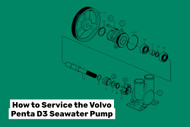How to Service the Volvo Penta D3 Seawater Pump
25th Nov 2025
Maintaining your Volvo Penta D3 engine is crucial to keeping your boat running smoothly and safely on the water. One important maintenance task is changing the seawater pump, which is responsible for circulating cooling water to your engine. A well-functioning seawater pump prevents overheating and engine damage, ensuring a reliable boating experience. This comprehensive guide will walk you through every step necessary to service the Volvo Penta D3 seawater pump efficiently and safely, even if you're a DIY enthusiast.
Why Service the Seawater Pump?
The seawater pump circulates fresh water or saltwater through your engine to cool it down during operation. Over time, the internal pump components, especially the impeller, experience wear and tear due to constant exposure to water and debris. Symptoms of a failing seawater pump include:
- Engine overheating
- Reduced water flow from the cooling system
- Leaks or visible damage on pump housing
- Unusual engine noises linked to pump malfunction
Replacing the seawater pump at regular intervals is essential for avoiding costly engine repairs and improving the longevity of your Volvo Penta D3 engine.
Tools and Preparation
Before you begin, gather the following tools and materials:
- Replacement seawater pump (compatible with Volvo Penta D3 engines)
- Set of screwdrivers and socket wrenches
- Gasket scraper or razor blade
- Marine-grade grease and lubricant
- New gasket or sealant
- Drain pan and cleaning rags
- Service manual for specific torque specifications and diagrams
Have a clean workspace with easy access to your engine, and ensure your boat is securely out of the water to avoid accidents.
Step 1: Ensure Safety and Prepare the Engine
Turning off the engine and disconnecting the battery reduces the risk of electrical shock or accidental engine start. Position your boat in a stable environment, preferably on a trailer for easy access and safe working conditions.
Step 2: Drain the Cooling System
Close the ball valve, place a drain pan beneath the seawater pump housing to catch any sea water. Open the drain plug, if available, and allow the entire system to drain completely. This prevents spills and water damage during the pump removal process.
Step 3: Remove the Pump Housing
Use appropriate socket wrenches to loosen and remove the bolts securing the pump housing. Carefully detach the housing to expose the impeller and internal pump components. Take care not to damage any hoses or adjacent parts.
Step 4: Remove the Old Impeller
Gently pull the impeller out of the housing using your fingers or an impeller removal tool. Inspect the impeller for cracks, wear, or missing blades. Dispose of the old impeller responsibly.
Step 5: Clean the Pump Housing
Using a gasket scraper or razor blade, clean any old gasket material, sealant, or debris from the housing surfaces. A clean surface ensures a tight and leak-free seal when the new pump is installed.
Step 6: Prepare and Install the New Impeller
Apply a thin layer of marine-grade grease to the new impeller’s blades. This facilitates easy insertion and reduces friction during pump operation. Insert the impeller, making sure it is oriented correctly according to your Volvo Penta D3 service manual (blades bent in the direction of rotation).
Step 7: Reinstall the Pump Housing
Place a new gasket or sealant on the cleaned surface and carefully align the pump housing back onto the engine block. Tighten all bolts evenly, following the torque specifications provided in the service manual. Tighten bolts diagonally to avoid misalignment.
Step 8: Open Cooling System and Test
After reassembly, open the ball valve for sea water to flow. Reconnect the battery and start the engine. Monitor for leaks and ensure the cooling water flows as expected from the exhaust outlet or designated water outlet points.
Additional Maintenance Tips
- Regularly inspect the seawater pump for signs of wear or damage, especially before extended trips.
- Change the impeller and gasket annually or according to manufacturer recommendations.
- Always use genuine Volvo Penta or quality aftermarket replacement parts like those manufactured by Albinus or Johnson Pump to maintain optimal engine performance.
- Flush the cooling system at least once a year to remove salt or debris build-up.
Troubleshooting Common Issues
- Low water flow: Check for clogged strainers or blocked intake hoses.
- Leaks: Inspect all hose clamps and gasket seals for damage.
- Noise or vibration: Bad impeller bearings or misalignment may be the cause, inspect and replace if necessary.
Conclusion
Servicing the Volvo Penta D3 seawater pump is a manageable DIY maintenance task that helps ensure your boat performs reliably. Regular maintenance extends engine life and prevents costly repairs caused by overheating. Investing in quality parts and following a careful replacement procedure keeps your marine engine healthy and your boating experience enjoyable.
FAQs
Q1: How do I know if my seawater pump needs servicing?
A: Signs include overheating, reduced water flow, leaks, or unusual noise during operation.
Q2: How often should I service the seawater pump?
A: Typically, annually or every 100 hours of engine operation, whichever comes first, or as recommended in your engine manual.
Q3: Can I replace the seawater pump myself?
A: Yes, with proper tools, parts, and guidance, replacing your seawater pump is a manageable DIY task.
Q4: What type of impeller is best for my Volvo Penta D3 engine?
A: Use OEM parts or high-quality aftermarket impellers designed specifically for Volvo Penta D3 series engines.
Q5: What’s the risk of not servicing a faulty seawater pump?
A: Overheating, engine damage, and costly repairs can occur if the cooling system fails.
Q6: What parts do I need to replace during the pump service?
A: The impeller, gasket or sealant, and optionally, the pump housing if damaged.
Q7: How long does it take to service the seawater pump?
A: Typically, 1-2 hours depending on your experience level.
Q8: What safety precautions should I take during service?
A: Disconnect the battery, ensure the engine is cool, and work in a well-ventilated, dry environment.

 Australian Dollars
Australian Dollars


